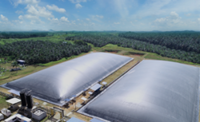Team leader K. Sridhar, center, closes the doors after a routine check of lithium ion batteries of 500-kilowatt battery energy storage system inside the Hindustan Coca-Cola Beverages factory in Thiruvallur District, on the outskirts of Chennai, India, Tuesday, July16, 2024. (AP Photo/Mahesh Kumar A.)
BEIJING: China is rushing to build battery-storage systems to allow electricity grids to cope with rapid increases in intermittent power generation from wind and solar farms.
But to truly capitalise on the technology, it needs to ensure they’re used more.





